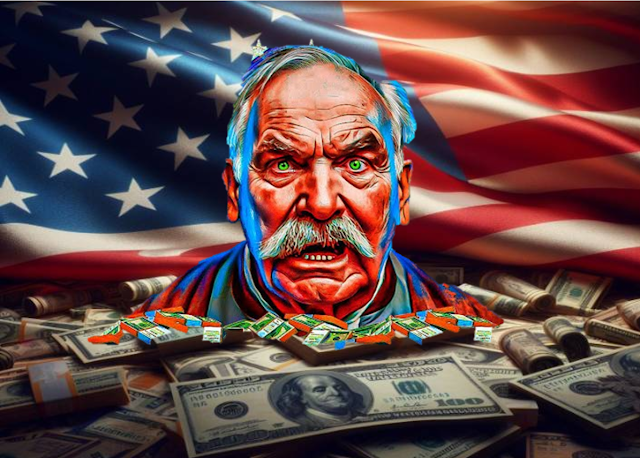Titan of Finance: Unraveling the Legend of J.P. Morgan !
INTRODUCTION
Wealth, power, and influence. J.P. Morgan had it all. The first
billion-dollar firm in the world was owned by him. He controlled the most
lucrative industries in America. And several times,
J.P. Morgan's decisions determined how the US economy
performed. With a simple word or the stroke of a pen, he could save a
company from collapse or doom it to bankruptcy. Disliked by some, adored
by others - there will never be another man quite like JP
Morgan. Let us see the tale of this legend.
AN UNPLEASANT START
In 1837, John Pierpont Morgan was born in Connecticut into a wealthy family.
Since John's father, Junius Spencer Morgan was already a successful
banker, he ensured his son received the best education possible to prepare him
for a career in finance. John was born into affluence, yet he had a
miserable upbringing. He was an ill little boy, who
suffered from several illnesses like seizures, coughs and scarlet fever.
Because of his health issues, he was frequently unable to play
outside with the other youngsters. Instead, you’d find him inside
studying financial statements.
John's father transitioned into a junior partner at a London-based
merchant banking firm named George Peabody & Co. Thanks to
his father's position, John secured a job on Wall Street with
the banking firm overseeing Peabody's interests in America. Part
of John's responsibilities included reporting to
his father's firm about the economic and political developments in
America, which was still an emerging market at the time. However, from an
early age, John's father worried that his son's impulsive
nature and quick temper might hinder his success as a financier. He
believed John needed to learn restraint and accountability. This concern was
highlighted in 1859 during a trip to New Orleans when John made what seemed
like a risky decision, using company funds to purchase an entire shipment of
Brazilian coffee without a confirmed buyer.
In 1861, at the age of 24, John decided to leave the stability of
his position in an established firm to venture out on his own. He founded his
own company, which continued to act as an agent for his father's bank
in England. John married his first love, a frail young girl named Amelia
Sturges. And for a quick duration, John turned into the
happiest he`d ever been. However, Amelia was diagnosed with
tuberculosis. John took her on a prolonged vacation to the Mediterranean,
hoping that the brand new weather may repair her power similar to
what John`s father had attempted for him while he was
younger - however, it turned into no use. Four months after their wedding, she
died. Understandably, John turned into an inconsolable mess,
and it`s believed, he never genuinely recovered from this.
Immediately after losing his wife, John threw himself deep into his
work more than ever. However whilst John was going through his
crisis, so was the United States - around this time the American
Civil War had broken out, and by the 1863 Conscription Act, John should go off
to fight in the war - but he didn’t. Instead, John paid $300 to be removed
from enlisting, and have a substitute stand in his
place. That's not to say John didn’t get involved in the
war though - in fact, on the contrary, he profited from it hugely.
One of the most notable examples was when he financed the purchase of 5,000
surplus Hall carbine rifles at $3.50 each from the government that were
considered too old to use. But then the consortium who bought them made some
minor adjustments and almost immediately sold the same rifles back to the
government for $22 each. It was an over 600% increase in price, and
thus whilst it was a very lucrative deal for John to be involved in,
this war profiteering was certainly not popular with the public or the
government.
THE RAILROAD TYCOON
In 1871, John saw a great opportunity to join forces with one of
the country's leading financiers Anthony Drexel.
Together they founded Drexel Morgan & Co., a private commercial
banking company. This company was later renamed simply JP Morgan
& Co. This is the company led by John for the rest of his life
and served as the precursor to the modern banking giant known today as JP
Morgan Chase. Early in his career, John was just a dealmaker, connecting
wealthy investors and visionaries in exchange for a share of the profits.
However, as John accumulated greater personal fortune and fame, he
was able to fund many of these projects himself.
John had already identified his first major investment, the
American railroad system. At the time, most other major industries were
controlled by single tycoons, such as Carnegie who controlled
the steel sector and Rockefeller who controlled the oil sector, but
railroads did not have a monopoly. The opposite was true, with so many
competitors offering very similar routes that they often lowered
their prices to attract customers. But while most companies were looking at the
railroad business and seeing intense competition, John saw an opportunity. In
his opinion, the answer lies in consolidation, in integrating railroads rather
than competing with each other. That's because John knew that the
bigger the company, the more it could benefit from economies of scale.
Therefore, John's goal has always been to transform several small
businesses into an integrated conglomerate. Because they owned all the
railroads in their neighbourhood, they suddenly could set the prices they
wanted instead of competing with each other to drive prices down. Therefore,
John invested heavily in several railroad companies and began consolidating
them. He would buy a cash-strapped railroad company, optimize its management
and operational efficiency, and consolidate its small businesses into a
powerful company. John used this tactic to such great effect that it
was even named after him, becoming known as “morganization.”
But what set John apart from other businessmen and investors of
his time was that he took a very active role in the governance of these
companies. John wasn't satisfied with simply buying
stocks and sitting back and making a profit. He was a man who
craved control. John had to be in charge, so he regularly used his
influential position on the board to run the company as he saw fit. He
intended to use his position to push for mergers and acquisitions that would
enrich himself and, of course, his investors and eliminate
competition. However, this also means that John could have
significant influence over the entire country's economy. And it
was always John's dream - to control the destiny of the country.
And over time, John began to accomplish just that.
THE MAN OF STEEL
In 1901, Carnegie Steel stood at its zenith. Dominating the steel industry,
it was one of the most valuable companies in the United States. Andrew
Carnegie, its founder, was ready to retire and sought a buyer for his company.
Enter John, a shrewd businessman with an appetite for bold deals. John
approached Carnegie and urged him to name his price. Carnegie did so, asking
for a staggering $480 million – an astronomical sum even
by today’s standards. Remarkably, John agreed on the spot, later
admitting he would have paid $100 million more. This landmark purchase marked
the birth of U.S. Steel, the world’s first billion-dollar
corporation. With a market cap of $1.4 billion, U.S. Steel dwarfed all other
manufacturing companies combined, which were capitalized at a
mere $9 billion.
But John’s ambitions didn’t stop there. He orchestrated
the merger of Carnegie Steel with the Federal Steel Company and other
businesses, creating U.S. Steel. Controlling two-thirds of American steel
production, John seemed invincible. Yet, he wasn’t content with steel
alone. John financed Thomas Edison’s early experiments with
electricity, leading to the creation of General Electric (GE). His influence
extended to the birth of what would later become AT&T. John’s knack
for combining companies into unstoppable giants was unparalleled. However, as
the 19th century drew to a close, the United States faced an
unprecedented depression. Decades of unchecked growth and speculative
investments culminated in a devastating economic bubble burst. The
American economy plunged into chaos, and John’s empire faced its
greatest challenge yet. And so, the stage was set for a new
chapter – a crisis that would test John’s mettle and resilience.
CRISES
In 1893, the United States faced an unprecedented depression
following decades of continuous growth and unregulated
investments. The bursting of the bubble led to chaos in the
American economy, with stocks losing nearly half their value, numerous
businesses closing permanently, and hundreds of banks going bankrupt.
Unemployment rates soared across the nation as foreign investors,
fearing the crisis, exchanged their American bonds for gold, gradually
depleting the U.S. reserves. As the dollar was then pegged to the
gold standard, ensuring that paper money could be converted into
physical gold, the government maintained a minimum of 100 million dollars in
gold bullion to back the currency. However, by 1895, most of this gold had been
exhausted, causing a sharp decline in the dollar's value. With
reserves dwindling to just nine million dollars, the government faced imminent
loan defaults, triggering further panic and withdrawals by investors.
The absence of a central bank left the U.S. without
a clear mechanism for rescue, presenting a dire situation.
Recognizing the gravity of the moment, President Cleveland realized that
conventional methods like issuing more bonds to the public wouldn't suffice. Entered John,
who saw the urgent need for bold action to avert economic disaster. John
proposed a daring plan: assemble a private syndicate comprising
the country's leading bankers, working alongside foreign investors,
to bolster America's gold reserves. Their syndicate offered to buy 65
million dollars worth of 30-year gold bonds using 3.5 million ounces of
gold. Leveraging an old Civil War statute, President Cleveland swiftly approved
the deal without waiting for congressional endorsement. With the agreement
signed, John coordinated with his associates in New York, swiftly securing all
the gold bonds in just 22 minutes. This decisive move quelled the
financial market's volatility and instilled confidence in the
economy, marking a turning point in America's economic recovery.
John's pivotal role in bailing out the government raised concerns about
the immense influence of a single banker on the entire U.S. economy. Some
questioned whether his motives were genuinely patriotic or merely opportunistic
to enrich himself. The relationship between big banks and the government
became a contentious issue, particularly among
Democrats. Despite this, John and his banker allies heavily supported the
Republican nominee, who ultimately won the election. This alignment allowed
John to maintain his close ties with the government. John's impactful
interventions in stabilizing the economy were not limited to one instance. In
1907, during another financial crisis, he played a crucial role once again.
Numerous banks were on the brink of collapse, prompting widespread panic and
withdrawals from bank accounts.
Facing this dire situation, President Roosevelt and John, despite their
differences, recognized the need for collaboration between government and big
business to avert a depression. Roosevelt turned to JP Morgan to tackle the
crisis, emphasizing the urgency of their joint efforts. J.P. Morgan summoned
dozens of the leading financiers and leaders of the nation's biggest
banks and trusts to join him in his private library on Madison Avenue and
decide on the best course of action. John's plan
was essentially for them to invest in their smaller competitors. John
concluded that although some banks would inevitably fail, others could
still be saved. So he and his associates deposited giant sums of money in
several banks so that they would be able to pay their depositors and avoid
declaring bankruptcy.
After revealing his plan, John then locked the door while the
bankers negotiated among themselves, literally locking them in until
they agreed on a resolution. By the morning, everyone had agreed
with John's plan, and with Roosevelt's approval, the U.S.
Treasury also contributed 25 million, showing the level of trust and respect
the president had for John's business sense.
What's remarkable is that John was 70 years old at this
point and negotiated all of this while having a terrible cold, meaning he
was constantly coughing and sneezing while saving the US economy. But his plan
ultimately worked. Lots of capital was injected back into the
economy, public confidence was
restored in America's banking system, and yet another
economic disaster was averted thanks to John's wheelings and
dealings. But whilst he was once again briefly labelled as a hero,
almost immediately people began to realize just how dependent they
had become on one single man. Something needed to change.
THE LEGACY
John faced heightened scrutiny as the era of the unchecked robber baron
gradually drew to a close. The American public grew increasingly cautious of
a select few businessmen wielding immense power and
influence. This led to John being summoned to testify
before Congress. The Pujo Committee was formed, which aimed to
investigate Wall Street's money trust and its impact on the American
economy. However, John never witnessed the full aftermath of
this investigation. On March 31st, 1913, the 75-year-old financier died while
on vacation in Rome. After his death, John's son took over the
business and continued its expansion. Even in the present day, there are
still concerns that the bank is too powerful. It has undergone countless
acquisitions and mergers over the years, something John himself would have been
proud of. One notable merger was with Chase Bank in the year 2000, creating JP
Morgan Chase with an estimated three trillion dollars in assets. After 200
years of consolidation in the banking industry, J.P. Morgan Chase is now the
biggest bank in the world by market capitalization. So, while opinions
may be divided on John Pierpont Morgan,
his story, is a fascinating one.




Indeed a legend on his own
ReplyDeleteIt was so intresting
ReplyDelete